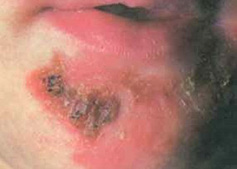PDF 92 KB
School sores appear as a flat, yellow, crusty or moist patch on the skin, usually on exposed parts of the body such as the face and legs - fact sheet.
School sores (impetigo) are a superficial skin infection caused by Staphylococcus or Streptococcus bacteria, or sometimes both. They are most common in children.
The bacteria can easily spread to other parts of the infected person’s body or to other people directly by contact with sores or indirectly by contact with contaminated clothes.
 School sores appear as a flat, yellow, crusty or moist patches on the skin (see image), usually on exposed parts of the body such as the face and legs. The sores are often greater than 1cm in diameter.
School sores appear as a flat, yellow, crusty or moist patches on the skin (see image), usually on exposed parts of the body such as the face and legs. The sores are often greater than 1cm in diameter.
Diagnosis is based on examination of the sores. Dry, cracked skin serves as an area for growth of the Streptococcus and Staphylococcus bacteria.
(time between becoming infected and developing symptoms)
4 to 10 days.
(time during which an infected person can infect to others)
As long as there is discharge from the sores. School sores are extremely infectious.
Your doctor may recommend antibiotic cream for mild and localised school sores. Antibiotics by mouth may be needed for multiple school sores and recurrent school sores.
Any sores on exposed surfaces should be covered with a watertight dressing.
School sores can be prevented by the following measures:
Image: Impetigo (school sore)